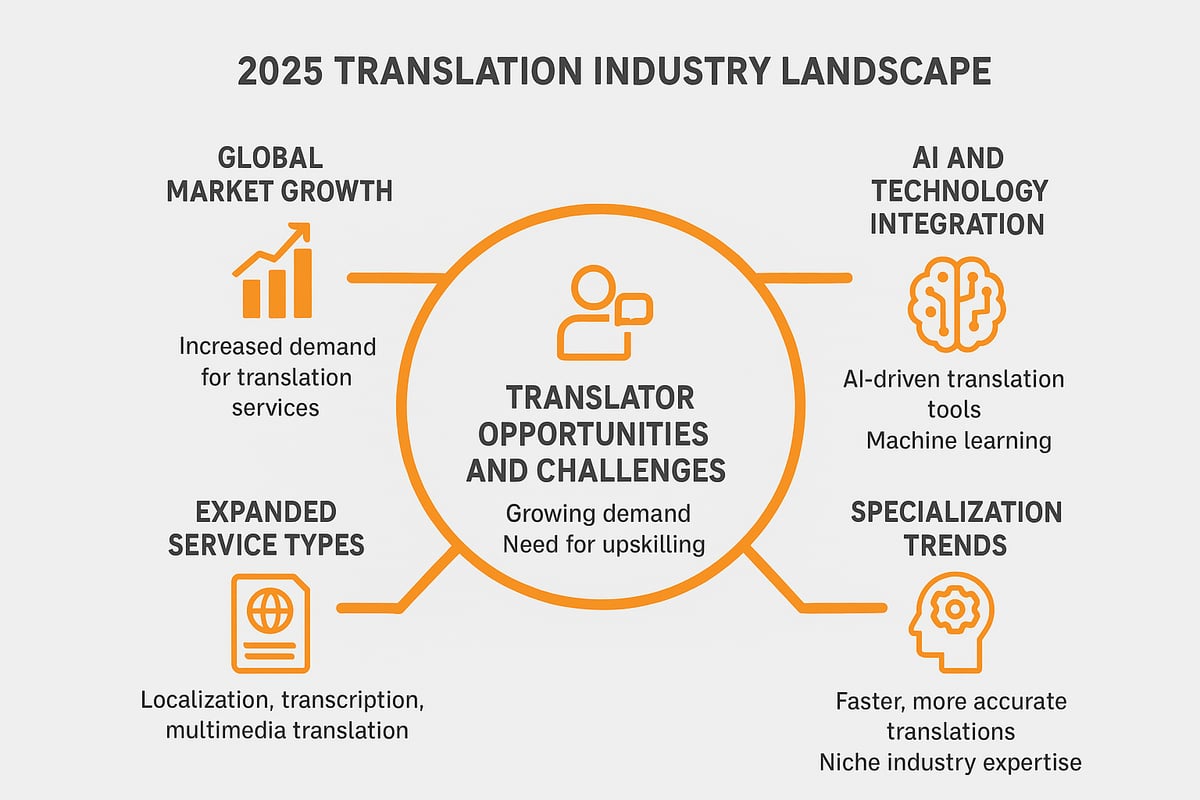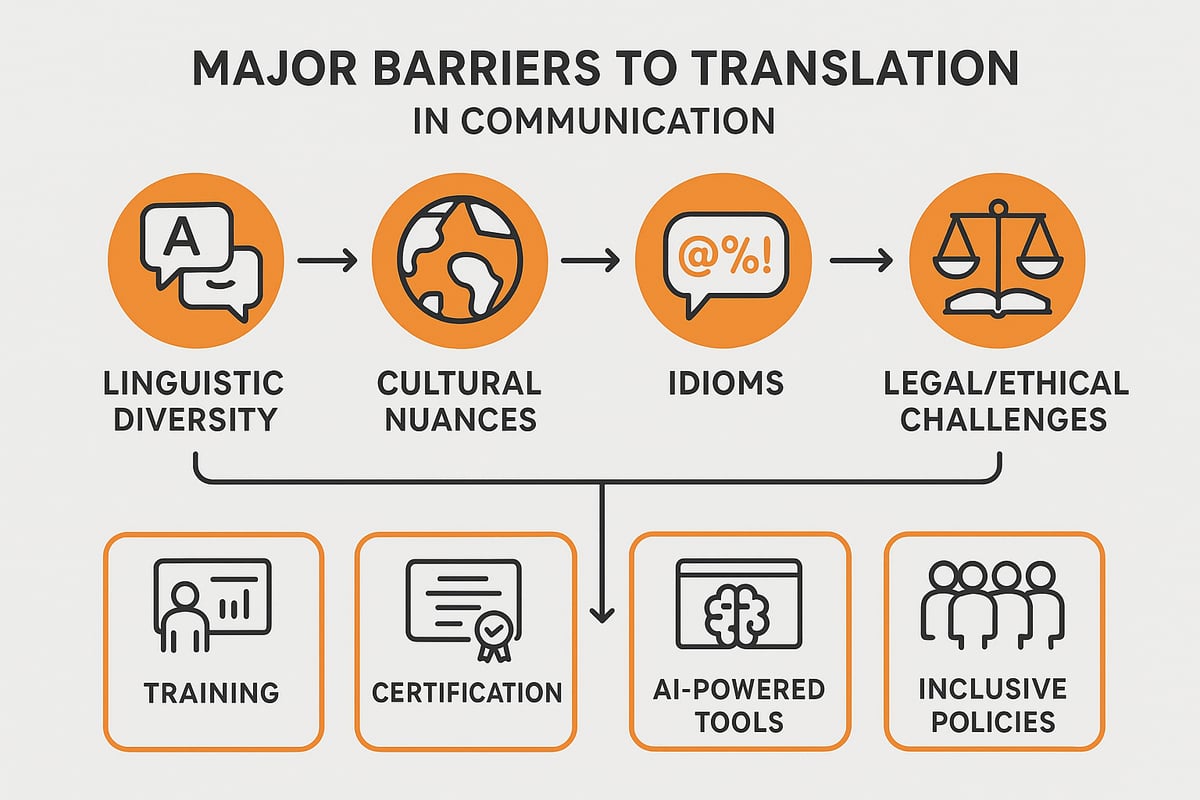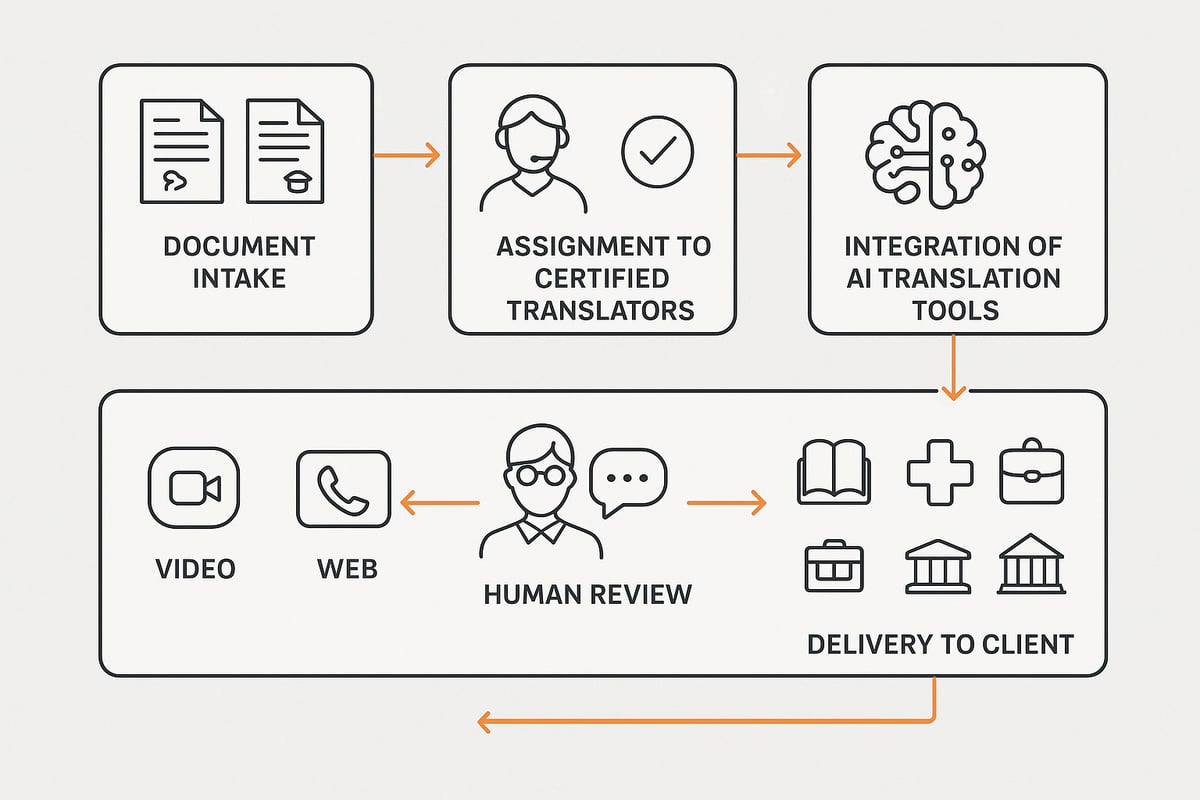The field of translation is experiencing rapid transformation as we approach 2025. What was once a...
8 Key Translation Areas to Know in 2025
The translation industry is entering a pivotal era as new technology and global trends reshape the demands on language professionals. In 2025, mastering the right translation areas will be essential for staying competitive and meeting the growing needs of businesses and organizations worldwide.
This article highlights the eight most important translation areas to focus on, preparing you for the challenges and opportunities ahead. We will explore emerging sectors, ongoing challenges, and specialized fields that are transforming the future of translation.
Are you ready to upskill and lead the way? Dive into each area to discover how you can stay ahead in this dynamic industry.
The Changing Landscape of Translation in 2025
The translation industry is undergoing a radical transformation as we approach 2025. Businesses, organizations, and linguists are witnessing new opportunities and challenges, making it essential to understand which translation areas are evolving most rapidly. As technology reshapes global communication, staying current is key for those seeking success in this dynamic field.
Several global trends are influencing translation areas in unprecedented ways. Artificial intelligence is becoming more sophisticated, allowing for faster but not always perfect translations. Globalization continues to push companies into new markets, while remote work has expanded the need for seamless multilingual collaboration. Digital transformation is driving demand for instant, accurate communication across languages, requiring translators to adapt quickly to new tools and workflows. As highlighted in Translation industry trends 2025, these forces are shaping the future of translation.
Industry regulations and the need for deep localization are fueling a rise in specialized translation areas. Sectors such as healthcare, legal, finance, and technology are demanding more precise, culturally relevant translations. This shift means that accuracy, speed, and cultural nuance are now baseline expectations rather than exceptions. Translators must also navigate complex regulatory landscapes, ensuring that every document meets local requirements without losing its intended meaning. The evolution of these translation areas is making expertise more valuable than ever.
Machine translation and post-editing are redefining traditional roles within translation areas. While automated tools handle routine content, human translators are increasingly tasked with high-stakes, nuanced assignments. Subject matter expertise is essential, especially in industries where errors can have serious consequences. Multilingual content is no longer a luxury but a necessity for global business expansion. According to recent data, the global language translation software and services market is projected to reach $65.6 billion by 2025, with medical, legal, and technical translation among the top-requested sectors. As the landscape continues to shift, mastering these translation areas will be vital for anyone aiming to lead in the next era of language services.
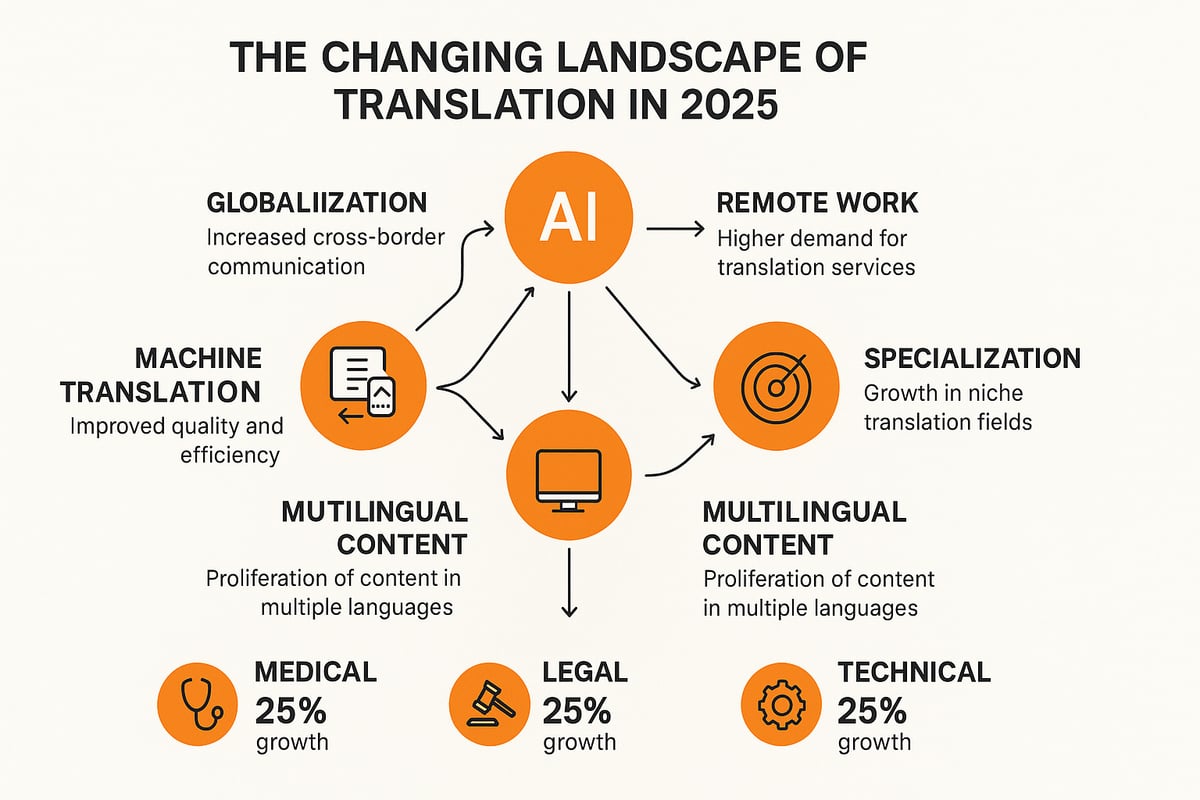
8 Key Translation Areas to Know in 2025
The landscape of translation areas is rapidly diversifying, and 2025 will demand sharper focus than ever before. Mastering the most critical translation areas is not just about language fluency but about deep specialization and adaptability.
Below, we explore the eight translation areas poised to shape the profession and global business in the coming year. Each area presents unique challenges, evolving demands, and major opportunities for those ready to upskill.
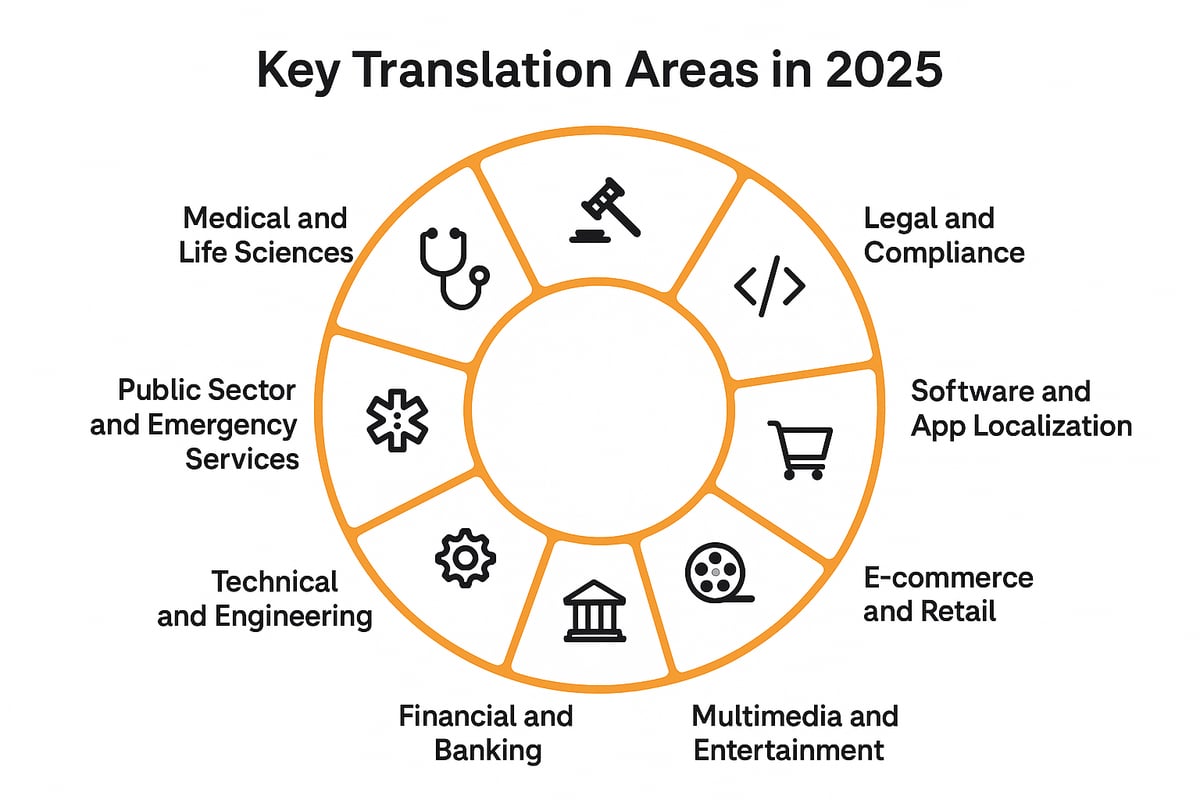
1. Medical and Life Sciences Translation
Medical and life sciences translation areas are experiencing unprecedented growth and complexity. The drive for innovation in healthcare, new medical technologies, and global health crises have made this one of the most in-demand translation areas.
Translators in this sector handle clinical trial documentation, patient records, pharmaceutical labeling, and regulatory submissions. Precision is paramount, as a single error can have serious consequences. Strict confidentiality and mastery of complex terminology define success in these translation areas.
Emerging technologies like telemedicine are expanding the scope of required translations. Regulatory bodies such as the FDA, EMA, and WHO set stringent standards for compliance, making expertise in these translation areas essential for global distribution.
A notable example is the translation of COVID-19 vaccine documentation for worldwide use. This required not only accurate medical terminology but also cultural adaptation for patient comprehension.
Statistics show medical translation as one of the fastest-growing translation areas, with double-digit annual growth. For a deep dive into how translation supports healthcare communication, see Multilingual healthcare communication strategies.
2. Legal and Compliance Translation
Legal and compliance translation areas are critical for cross-border operations and regulatory adherence. The expansion of international business has increased demand for linguists skilled in contracts, patents, litigation materials, and compliance documents.
The complexity of legal jargon and the risk of mistranslation can result in significant financial loss or lawsuits. Certified translations and sworn translators are often required, especially for official proceedings.
Translation areas in legal fields also support international arbitration and dispute resolution. For example, translating GDPR compliance documents is essential for companies operating in multiple jurisdictions.
According to industry data, legal translation areas represent a substantial share of the global language services market. The demand for accuracy and confidentiality in these translation areas will only continue to rise.
3. Software and App Localization
The software and app localization translation areas are expanding rapidly as digital products reach global audiences. Developers rely on translators to adapt user interfaces, documentation, and UX content for diverse markets.
Key challenges include handling code strings, maintaining context, and ensuring platform compatibility. Continuous localization is essential in agile development cycles, keeping translations up-to-date as features evolve.
Cultural adaptation within these translation areas increases user engagement and retention. For instance, localizing a fintech app for multiple regions requires not just language changes but also adjustments to visual elements and workflows.
Data consistently show that software localization in translation areas can drive substantial user growth and revenue. This makes it an indispensable focus for translation professionals in 2025.
4. E-commerce and Retail Translation
E-commerce and retail translation areas have surged with the global online shopping boom. Translating product descriptions, reviews, and customer support is now standard for businesses seeking international reach.
SEO and keyword localization are vital within these translation areas to ensure visibility in global search results. Handling payment, shipping, and returns information in multiple languages builds trust and improves conversion rates.
Effective translation in this sector means adapting marketing campaigns for local events, such as Black Friday in different countries. The impact is clear: a significant percentage of consumers prefer to shop in their native language, underlining the importance of these translation areas.
5. Multimedia and Entertainment Translation
Multimedia and entertainment translation areas are thriving amid the global rise in streaming, gaming, and digital media. Services like subtitling, dubbing, and audio description require linguistic skill and technical expertise.
Cultural adaptation is crucial for humor, idioms, and sensitive content. Technical considerations, including timing and lip-sync, further complicate these translation areas.
The growth of user-generated content and influencer marketing also increases demand for translation. Localizing a video game launch, for example, involves adapting language, visuals, and audio for multiple regions.
Global revenues from translated entertainment content continue to climb, making these translation areas an exciting prospect for translators seeking dynamic career paths.
6. Financial and Banking Translation
Financial and banking translation areas are evolving with the expansion of fintech, mobile banking, and international investment. Translators in this sector must handle annual reports, disclosures, and compliance documents with utmost accuracy.
Confidentiality and regulatory compliance are non-negotiable in these translation areas. Regulations such as IFRS, FATCA, and anti-money laundering laws drive the need for specialized knowledge.
Translation supports investor relations and global mergers by ensuring clear, accurate communication. For example, translating IPO documents for international investors is a high-stakes task requiring expertise in these translation areas.
Data confirm that financial translation areas contribute significantly to language service industry revenues, reflecting ongoing growth.
7. Technical and Engineering Translation
Technical and engineering translation areas are increasingly vital due to advances in manufacturing, automotive, and energy sectors. Translators must be proficient with manuals, safety guides, patents, and technical specifications.
Deep subject matter expertise is required, as industry terminology can be highly specialized. The rise of IoT, AI, and Industry 4.0 has increased the volume and complexity of technical documentation.
These translation areas play a pivotal role in global product launches. For example, translating user manuals for renewable energy equipment ensures safe and effective use worldwide.
Technical translation areas remain a major segment in B2B localization, with strong demand projected into 2025.
8. Public Sector and Emergency Services Translation
Public sector and emergency services translation areas are essential for supporting increasingly diverse populations. Translating government communications, legal notices, and health alerts ensures equitable access to public services.
Language access is critical during emergencies. Translators provide essential support by adapting evacuation instructions and health warnings for affected communities.
Compliance with language access laws, such as Title VI in the US, makes these translation areas a legal requirement for many organizations. Translating during natural disasters can directly impact public safety outcomes.
Data underscores that language barriers can negatively affect emergency response, highlighting the ongoing importance of these translation areas.
Essential Skills and Tools for Translators in 2025
The translation industry is entering a new era, where mastering essential skills and tools is vital for anyone working across translation areas. As human expertise merges with advanced artificial intelligence, translators need to adapt quickly to hybrid workflows and stay ahead of industry changes.
Translators now rely on a suite of digital resources to deliver quality at scale. These include:
- Computer-assisted translation (CAT) tools
- Terminology management systems
- Quality assurance (QA) software By integrating these platforms, professionals ensure consistency and accuracy in all translation areas.
Continuous professional development is more important than ever. Specializing in high-demand translation areas, such as medical or legal fields, gives linguists a competitive edge. Online courses, certifications, and industry workshops help translators keep pace with evolving standards and regulations.
Collaboration is also key. Working closely with subject matter experts and in-country reviewers allows translators to refine their work, address regional nuances, and maintain credibility. This teamwork is especially crucial in regulated or technical translation areas.
Cultural intelligence and localization strategy are growing priorities. As global markets diversify, translators must understand local customs, humor, and sensitivities. Embracing technology trends, such as those explored in Translation technology advancements, can help professionals stay at the forefront of the industry.
To succeed in 2025, translators need to build a portfolio that highlights expertise in multiple translation areas, showcases adaptability, and demonstrates proficiency with the latest tools. Investing in these skills today ensures readiness for the evolving demands of tomorrow.

Future Challenges and Opportunities in Translation
As technology rapidly evolves, new translation areas are emerging, from voice AI and augmented reality to machine learning localization. This shift means translators must master both technical skills and ethical judgment, especially as sensitive content and cultural nuances become even more important.
AI is transforming how professionals approach translation areas, bringing opportunities and challenges. Hybrid workflows that blend human expertise with AI tools are becoming standard. For example, the future of translation will likely rely on seamless AI and human interpreters in emergency communication, ensuring both speed and accuracy in critical situations.
Maintaining high-quality standards is essential. New developments like machine translation benchmarking help set domain-specific guidelines, supporting reliable results across industries. As translators act as cultural mediators and technology integrators, those who adapt quickly will find exciting opportunities in specialized translation areas.
Translators who stay proactive, invest in upskilling, and embrace innovation will be well-positioned to thrive in this dynamic landscape.
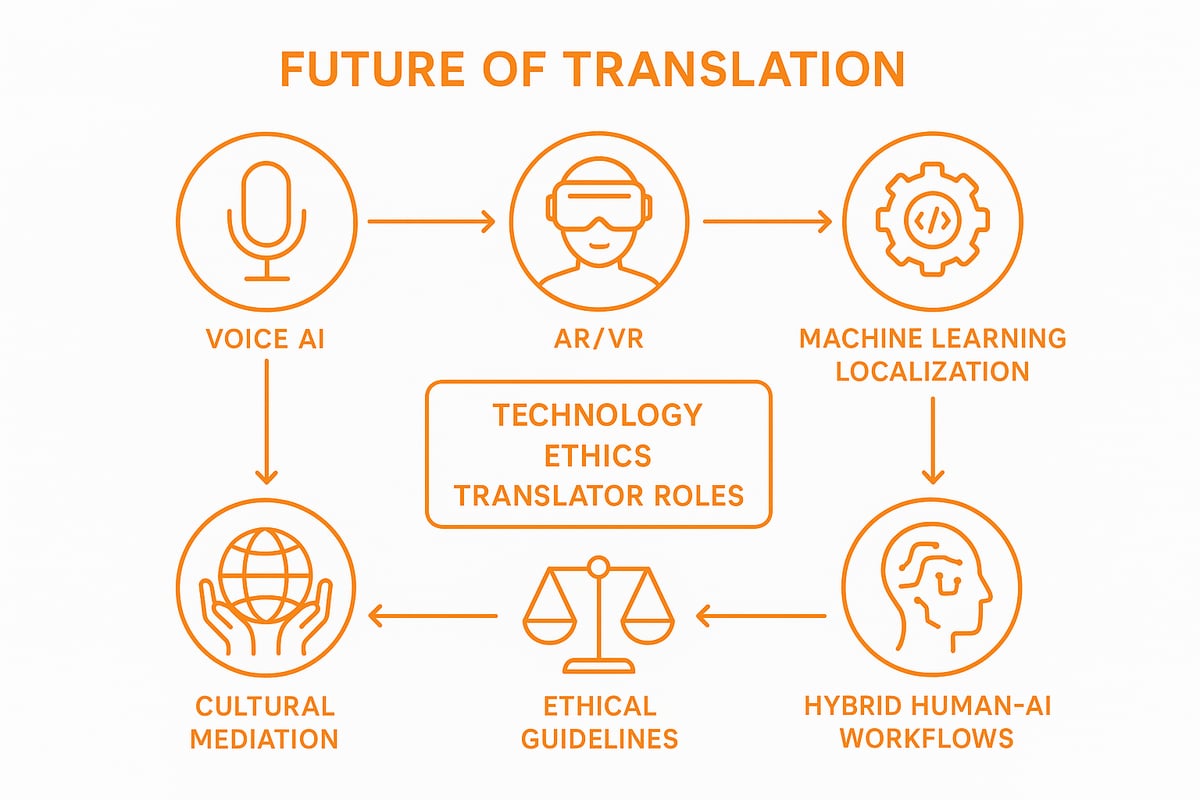
As we’ve explored, mastering these eight translation areas in 2025 isn’t just about staying current—it’s about making a real impact where communication matters most. Whether you’re a language professional, emergency manager, or tech innovator, bridging language gaps can save lives and transform communities. If you want to see firsthand how advanced translation technology is reshaping emergency communications, you can Book a Demo with Convey911. Discover how solutions like real time multilingual support empower you to serve diverse populations with clarity and confidence.

